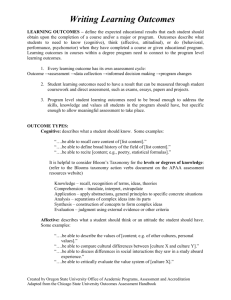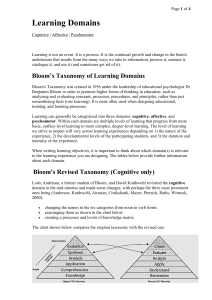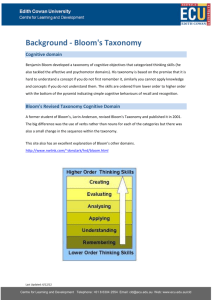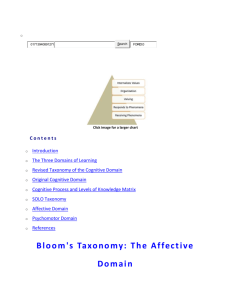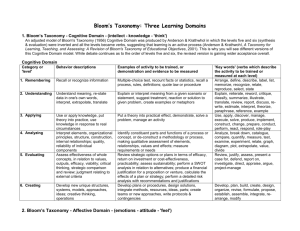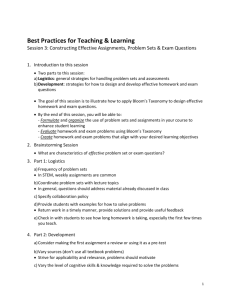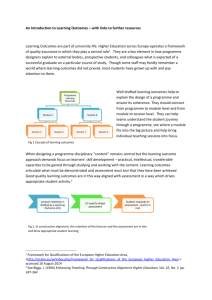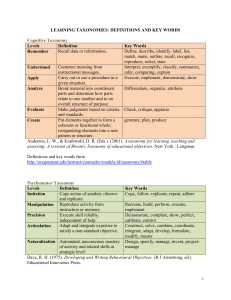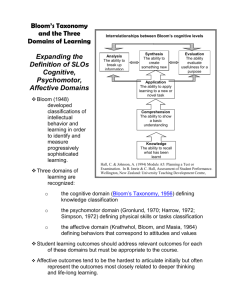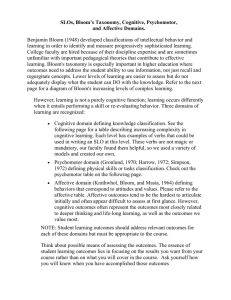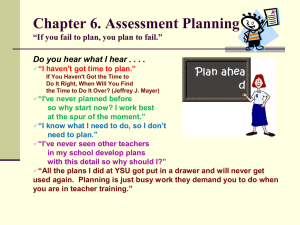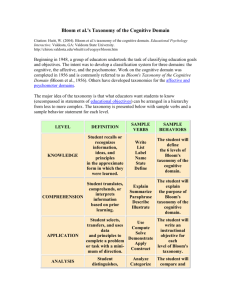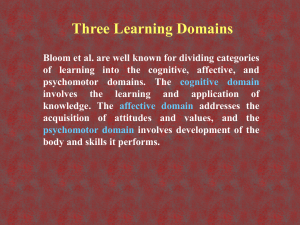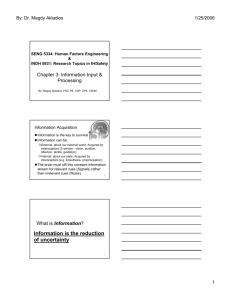Mr.Bloom`s Cognitive Verbs (Primary)
advertisement
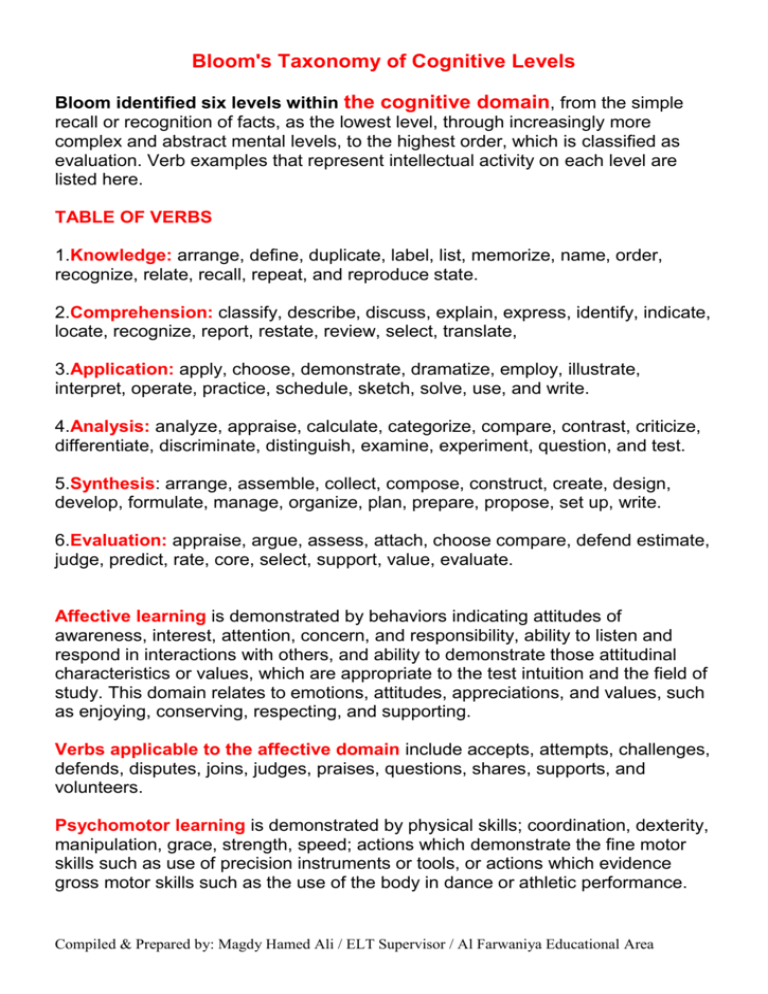
Bloom's Taxonomy of Cognitive Levels Bloom identified six levels within the cognitive domain, from the simple recall or recognition of facts, as the lowest level, through increasingly more complex and abstract mental levels, to the highest order, which is classified as evaluation. Verb examples that represent intellectual activity on each level are listed here. TABLE OF VERBS 1.Knowledge: arrange, define, duplicate, label, list, memorize, name, order, recognize, relate, recall, repeat, and reproduce state. 2.Comprehension: classify, describe, discuss, explain, express, identify, indicate, locate, recognize, report, restate, review, select, translate, 3.Application: apply, choose, demonstrate, dramatize, employ, illustrate, interpret, operate, practice, schedule, sketch, solve, use, and write. 4.Analysis: analyze, appraise, calculate, categorize, compare, contrast, criticize, differentiate, discriminate, distinguish, examine, experiment, question, and test. 5.Synthesis: arrange, assemble, collect, compose, construct, create, design, develop, formulate, manage, organize, plan, prepare, propose, set up, write. 6.Evaluation: appraise, argue, assess, attach, choose compare, defend estimate, judge, predict, rate, core, select, support, value, evaluate. Affective learning is demonstrated by behaviors indicating attitudes of awareness, interest, attention, concern, and responsibility, ability to listen and respond in interactions with others, and ability to demonstrate those attitudinal characteristics or values, which are appropriate to the test intuition and the field of study. This domain relates to emotions, attitudes, appreciations, and values, such as enjoying, conserving, respecting, and supporting. Verbs applicable to the affective domain include accepts, attempts, challenges, defends, disputes, joins, judges, praises, questions, shares, supports, and volunteers. Psychomotor learning is demonstrated by physical skills; coordination, dexterity, manipulation, grace, strength, speed; actions which demonstrate the fine motor skills such as use of precision instruments or tools, or actions which evidence gross motor skills such as the use of the body in dance or athletic performance. Compiled & Prepared by: Magdy Hamed Ali / ELT Supervisor / Al Farwaniya Educational Area Verbs applicable to the psychomotor domain include bend, grasp, handle, operate, reach, relax, shorten, stretch, write, differentiate (by touch), express (facially), perform (skillfully). LEVEL DEFINITION SAMPLE VERBS SAMPLE BEHAVIORS KNOWLEDGE: Student recalls or recognizes information, ideas, and principles in the approximate form in which they were learned. Write List Label Name State Define. The student will define the 6 levels of Bloom's taxonomy of the cognitive domain. COMPREHENSION: Student translates, comprehends, or interprets information based on prior learning. Explain Summarize Paraphrase Describe Illustrate The student will explain the purpose of Bloom's taxonomy of the cognitive domain. APPLICATION: Student selects, transfers, and uses data and principles to complete a problem or task with a mini-mum of direction. Use Compute Solve Demonstrate Apply Construct The student will write an instructional objective for each level of Bloom's taxonomy. ANALYSIS: Student distinguishes, classifies, and relates the assumptions, hypotheses, evidence, or structure of a statement or question. Analyze Categorize Compare Contrast Separate. The student will compare and contrast the cognitive and affective domains. SYNTHESIS: Student originates, integrates, and combines ideas into a product, plan Or proposal that is new to him or her. Create Design Hypothesize Invent Develop. The student will design a classification scheme for writing educational objectives that combines the cognitive, affective, and psychomotor domains. EVALUATION: Student appraises, assesses, or critiques on a basis of Specific standards and criteria. Judge Recommend Critique Justify. The student Will judge the effective-ness of writing objectives using Bloom's taxonomy. It is clear that students can "know" about a topic or subject at different levels. While most teacher-made tests still test at the lower levels of the taxonomy, research has shown that students remember more when they have learned to handle the topic at the higher levels of the taxonomy. This is because more elaboration is required, a principle of learning based on finding from the information processing approach to learning. The taxonomy was developed to organize levels of commitment. As such it could just as properly be discussed as a regulatory system issue in the model being presented here. Affective Domain Compiled & Prepared by: Magdy Hamed Ali / ELT Supervisor / Al Farwaniya Educational Area Level Definition Example Receiving Being aware of or attending to something in the environment Person would listen to a lecture or presentation about a structural model related to human behavior. Responding Showing some new behaviors as a result of experience. The individual would answer questions about the model or might rewrite lecture notes the next day. Valuing Showing some definite involvement or commitment. The individual might begin to think how education may be modified to take advantage of some of the concepts presented in the model and perhaps generate a set of lessons using some of the concepts presented. Organization Integrating a new value into one's general set of values, giving it some ranking among one's general priorities. This is the level at which a person would begin to make long-range commitments to arranging his or her instruction and assessment relative to the model. Characterization by Value Acting consistently with the new value. At this highest level, a person would be firmly committed to utilizing the model to develop, select, or arrange instruction and would become known for that action. Compiled & Prepared by: Magdy Hamed Ali / ELT Supervisor / Al Farwaniya Educational Area
